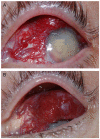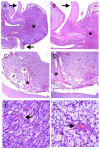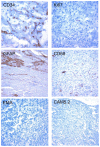Scleral penetration of an unusually aggressive case of a retinal hemangioblastoma
- PMID: 23931485
- PMCID: PMC4005102
- DOI: 10.1016/j.jcjo.2013.01.014
Scleral penetration of an unusually aggressive case of a retinal hemangioblastoma
Figures




Similar articles
-
Aggressive-fungating retinal hemangioblastoma.J Cancer Res Ther. 2021 Jan-Mar;17(1):279-281. doi: 10.4103/jcrt.JCRT_718_18. J Cancer Res Ther. 2021. PMID: 33723171
-
Clinically unsuspected retinal hemangioblastoma in a blind eye as the initial manifestation of von Hippel-Lindau disease.Pathol Res Pract. 2012 Mar 15;208(3):186-8. doi: 10.1016/j.prp.2011.12.007. Epub 2012 Jan 26. Pathol Res Pract. 2012. PMID: 22281434
-
[Retinal capillary hemangioblastoma in Von Hippel-Lindau disease].J Fr Ophtalmol. 2017 Jan;40(1):80-81. doi: 10.1016/j.jfo.2016.10.006. Epub 2017 Jan 10. J Fr Ophtalmol. 2017. PMID: 28087080 French. No abstract available.
-
Haemangioblastoma, haemangioblastomatosis, and von Hippel-Lindau disease.Adv Tech Stand Neurosurg. 1993;20:197-304. doi: 10.1007/978-3-7091-6912-4_6. Adv Tech Stand Neurosurg. 1993. PMID: 8397535 Review. No abstract available.
-
Von hippel-lindau disease: a genetic and clinical review.Semin Ophthalmol. 2013 Sep-Nov;28(5-6):377-86. doi: 10.3109/08820538.2013.825281. Semin Ophthalmol. 2013. PMID: 24138046 Review.
Cited by
-
Retinal Hemangioblastoma with Extraocular Extension: Report of Three Cases.Ocul Oncol Pathol. 2021 Jun;7(3):177-181. doi: 10.1159/000512173. Epub 2021 Jan 7. Ocul Oncol Pathol. 2021. PMID: 34307328 Free PMC article.
References
Publication types
MeSH terms
Substances
Grants and funding
LinkOut - more resources
Full Text Sources
Other Literature Sources
Medical

